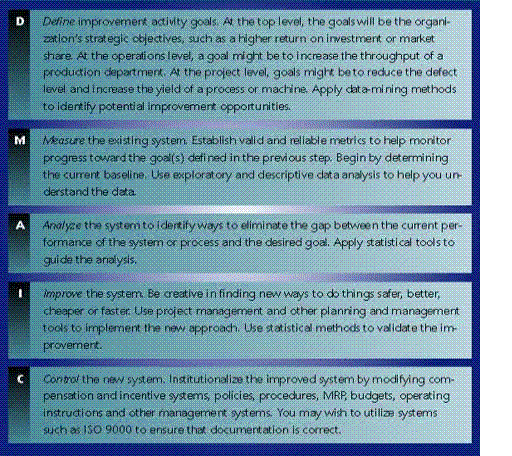|
The DMAIC Process
Prepared by: Ng Choy Moon
Date: 13th October
2004
Overview of
Six Sigma
Six Sigma is a process-improvement
methodology widely used in business today or a plan for analyzing
and improving a business function by large organization while DMAIC
is used to guide Six Sigma process-improvement projects.
DMAIC Framework
The DMAIC process of Six Sigma consists
of Define, Measure, Analyze, Improve, and Control can be applied to
existing internal processes.
At the basic level, DMAIC can be utilized as an excellent
framework for process improvement without commencing upon a
full-blown Six Sigma corporate initiative. This is not to encourage
sloppy or incomplete process-improvement efforts through halfway of
Six Sigma implementation, but it is rather to encourage employees to
leverage the many tools of Six Sigma without getting lost in rigid
methodology that may damage their productivity and efficiency.

Table
1: DMAIC Framework (Source:
www.isixsigma.com)
Applying Six Sigma in Coding
Performance Improvement Project
1.
The Define Phase
Customer Training Department had
provided us some initial data on which to start. At the project
kickoff, draft charter was distributed to team members and the work
of refining and filling in the missing pieces began. Form the
available data; the team has managed to find an opportunity to
reduce development time and development cost. As the team worked to
perfect the charter which includes
business case, problem and goal statements, project scope,
milestones, roles and responsibilities, we had also conduct
discussions on industryís standard for the project and which
benchmark to use. Thus, the team may focus its work on documenting
and analyzing the current projectís process. Business processes are
mapped through
completed SIPOC representation, describing the Suppliers, Inputs,
Process, Outputs, and Customers. The problem/opportunity,
process, goals and user requirements became clear since the team
went through the exercise of developing this map.
In efforts of defining user
requirements, the team review usersí feedbacks while conducting
surveys to know the importance of the system. The team then can use
the results to identify the weakness and underlying issues behind
them.
2.
The Measure Phase
Data collection is planned and executed
in order to ensure the credibility of the data that would be
collected. This plan would indicate what sample would be collected,
how and when it would be collected, where it would be collected
from, who would collect it, and the most important point; clear
descriptions of what data was to be observed and measured.
Once the data collection was completed,
the process variation components were displayed using Pareto charts
and histograms, which provide the team a visual representation of
the current project state. After that, the team now had a baseline
measure of how well the project was performing and able to identify
improvement opportunities.
3.
The Analyze Phase
In this phase, the team will analyze
whether current process had met the critical quality (CTQ)
requirements. A root cause analysis on development time and
percentage of rework requirements is conducted to generate list of
possible causes, segment and stratify the possible causes. Once all
potential root causes of both rework and additional development time
were identified, the team then used multi-voting to derive a
prioritized list of the root causes and their impact on project
development. The results of this prioritization will be displayed in
a Pareto chart.
There was an area where the team found
an opportunity to reduce cost and development time. The team may cut
down the working time of members to save cost and also reduce their
pay. Through this cost reduction, wastage of time and financial can
be reduced dramatically to improve the ROI.
4.
The Improve Phase
In this phase, the team was focused on
producing a better possible solution to counter the deficiencies
occurred. To accomplish this, the team identified, evaluated,
selected and developed solutions using a variety of traditional and
non-traditional idea generation tools.
The team generated solutions using a
variety of tools including brainstorming and fishbone diagrams. Once
the ideas were generated the programs were tested and best solution
was selected. Solution
implementation plan was established, which includes work breakdown
structure, resources, risk management plan, cost/budget, and control
plan.
5.
The Control Phase
Control phase is where the performance
of the process of project is routinely monitored to ensure that
critical customer requirements continue to be met. In this phase,
standardized documentation was produced and the programs were
implemented. The procedures for this project were also documented
for further reference and alterations. The program performance was
monitored to determine whether it meet user and customer
requirement. Knowledge
gained on process was shared and institutionalized to everyone so
that continuous learning and improvements exist.
Conclusion
Every team member just know how to say
without any action or work completed due to poor work breakdown
structure and task assignments. So, in this case, the members have
legitimate complaints. But after a detailed WBS and task
responsibilities were developed, the works were done on time.
Kevinís complaints on budget and deadline were a normal response of
a senior executive; as a top management main concern will be only
the organizationís benefits. Delayed project and over budget will
cause loss to the company and also decreases the demand of
customers.
Whether Six Sigma is the best choice of
a methodology or not, it will still depends on work culture, social,
technological, and the resources available. At a basic level, the
Six Sigma methodology can be beneficial to any organization
embarking on a process-improvement endeavor in sourcing and
selection.
back to top
|